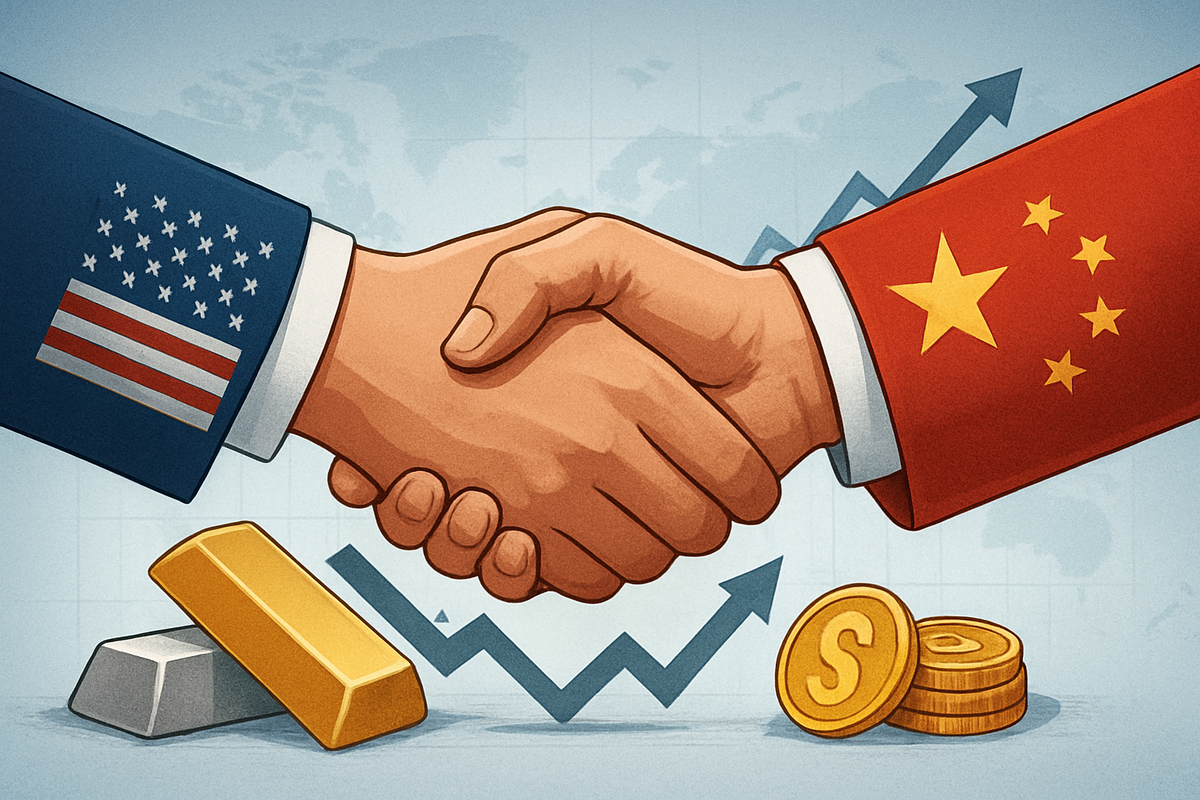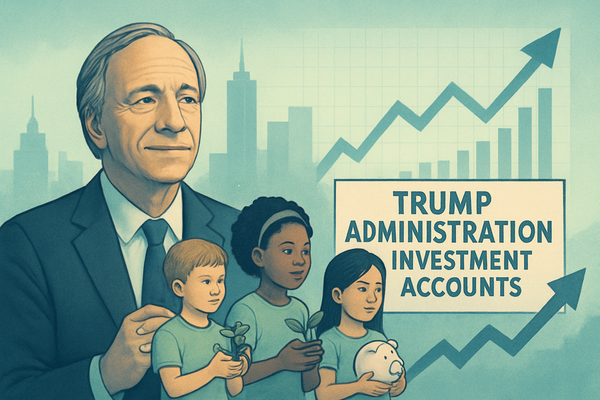Gold and Silver Tumble as US-China Trade Deal Hopes Ignite Risk-On Sentiment

Kuala Lumpur, Malaysia – October 27, 2025 – Global financial markets are buzzing with optimism this Monday morning, as renewed hopes for an imminent US-China trade deal have sent a wave of relief through investors. The prospect of de-escalating trade tensions has, however, delivered a significant blow to the prices of gold and silver, traditionally viewed as safe-haven assets. As capital rapidly shifts from defensive positions to riskier investments, the precious metals market is experiencing a sharp correction, marking a pivotal moment for commodity traders and global economic outlook.
The breakthrough, which solidified over the weekend of October 25-26, 2025, emerged after top Chinese and U.S. economic officials outlined a trade deal framework during the Association of Southeast Asian Nations (ASEAN) summit in Malaysia. This preliminary consensus sets the stage for a highly anticipated meeting between US President Donald Trump and Chinese President Xi Jinping in South Korea on Thursday, October 30, to finalize what could be a pivotal agreement. The immediate implication has been a noticeable downturn in gold and silver, with spot gold dropping as much as 1.4% to trade near $4,053 an ounce, extending a 3.3% loss from the previous week. Silver mirrored this trajectory, sliding 1.59% to $47.83 per ounce, following an 11.3% plunge last week—its steepest weekly decline since September 2020.
A Framework for De-escalation: Details, Timeline, and Key Players
The newly established trade framework, forged after intensive negotiations, aims to prevent further escalation of tariffs and stabilize critical supply chains. Key components of this preliminary agreement include a commitment to pause escalatory trade actions, notably preventing the US from imposing 100% tariffs on Chinese imports scheduled for November 1. Crucially, China has also agreed to defer rare earth export licensing for one year, providing significant relief to industries reliant on these critical materials. Furthermore, China has pledged to resume "substantial" purchases of US agricultural products, particularly soybeans, offering a much-needed boost to American farmers. Other issues addressed include fentanyl trafficking, port entrance fees, and a "final deal" regarding the sale of TikTok's US operations.
This breakthrough follows a tumultuous period of trade relations throughout 2025. After his re-inauguration, President Trump reignited tariff disputes, leading to a "tit-for-tat" escalation with tariffs reaching up to 145% on Chinese goods and 125% on US goods. China also introduced rare-earth export restrictions during this period. May 2025 saw initial discussions in Geneva and a 90-day ceasefire, followed by further trade talks in London in June that led to significant tariff reductions. October 9, 2025, saw China tighten rare earth export controls, setting the stage for the intense, five-round negotiations that culminated in Kuala Lumpur on October 26-27. The upcoming meeting between President Trump and President Xi Jinping at the APEC summit in Gyeongju, South Korea, will be their first face-to-face encounter since Trump's return to the White House.
Key players in these complex negotiations include US President Donald Trump, Treasury Secretary Scott Bessent, and US Trade Representative Jamieson Greer. On the Chinese side, President Xi Jinping, Vice Premier He Lifeng, and Vice Minister Li Chenggang have been central figures. The immediate market reactions to this optimistic news have been overwhelmingly positive across global equities, with Asian stock markets surging and US stock indexes poised for record highs. The US dollar weakened as investors shifted towards riskier assets, while commodities like copper neared an all-time high, and soybeans advanced on expectations of improved demand. Conversely, US Treasury yields rose, indicating a rotation away from defensive investment positions.
Companies Navigating the Trade Winds: Winners and Losers
The anticipated US-China trade deal creates a distinct divide between potential winners and losers in the public markets, fundamentally shifting investor sentiment away from safe havens and towards growth-oriented sectors.
On the losing side are inevitably the gold and silver mining companies. As safe-haven demand diminishes and precious metal prices fall, their revenue streams and profit margins come under direct pressure. Major players such as Newmont (NYSE: NEM), the world's largest gold producer, and Barrick Gold (NYSE: GOLD) will see their financial performance directly impacted by sustained lower gold prices. Similarly, silver-focused miners like First Majestic Silver (TSX: AG) and Pan American Silver Corp. (NASDAQ: PAAS) are highly sensitive to global silver market dynamics. Even streaming companies like Wheaton Precious Metals Corp. (NYSE: WPM), which profit from rising prices, will feel the pinch of a downturn. Companies with higher "all-in sustaining costs" (AISC) per ounce or significant debt are particularly vulnerable to margin compression, potentially leading to operational cutbacks or deferred exploration projects.
Conversely, sectors that stand to gain significantly from improved trade relations include agriculture, technology, and industrial goods. US agricultural producers, especially those involved in soybeans, corn, and wheat, are poised for a substantial rebound. Agribusiness giants like Archer Daniels Midland (NYSE: ADM) and Bunge Limited (NYSE: BG) could see a significant recovery in export earnings as China resumes "substantial" purchases of US agricultural products. Manufacturers of agricultural machinery such as Deere & Co. (NYSE: DE) could also benefit from increased farmer incomes and renewed confidence. In the technology sector, companies like Qualcomm (NASDAQ: QCOM), Micron Technology (NASDAQ: MU), and Apple (NASDAQ: AAPL), which have significant revenue exposure to China or rely on stable supply chains for components like rare earth minerals, stand to benefit from reduced tariffs, eased export controls, and a more predictable operating environment. Industrial goods companies, including heavy machinery manufacturers like Caterpillar Inc. (NYSE: CAT) and those involved in base metals, are likely to see increased demand and improved pricing as global industrial activity picks up.
Wider Significance: Reshaping Global Trade Dynamics
The hopes for a US-China trade deal represent more than just a temporary truce; they underscore profound shifts in global economic sentiment and trade dynamics. This event fits into a broader trend where geopolitical considerations increasingly intertwine with economic policy. The immediate "risk-on" rally in global equities, coupled with the flight from safe-haven assets, signals a collective sigh of relief from investors, who view de-escalation as a positive for global economic stability and growth.
However, despite this optimism, the underlying trend of supply chain resilience and diversification is expected to persist. Companies have largely adopted "China+1" strategies to reduce over-reliance on a single manufacturing hub, a strategic decoupling unlikely to be fully reversed. While the easing of rare earth export restrictions provides crucial breathing room for technology supply chains, the drive to build domestic or allied production capabilities, exemplified by pacts like the US-Australia critical minerals agreement, will likely continue. This cautious de-escalation is not a full reversal of deglobalization but rather a managed approach to strategic competition, where national security concerns continue to reshape global trade and supply chains.
The ripple effects extend globally. While US exporters, particularly in agriculture, stand to gain, there's a risk of "trade diversion" if China grants privileged market access to the US without broader liberalization, potentially impacting other countries. Conversely, major trading partners like European nations and Japan could benefit from stabilized global supply chains and lower input costs. Regulatory and policy implications highlight the use of trade policy as a national security tool, with issues like rare earth minerals and technology export controls now firmly recognized as both economic and strategic concerns. Historically, this situation draws parallels to the 2018-2020 trade war and the "Phase One" deal, which offered a temporary truce but failed to resolve deeper structural issues, ultimately leading to renewed tensions and a continued push for economic decoupling.
What Comes Next: Scenarios and Strategic Shifts
The path forward for US-China trade relations, and consequently for global markets, remains a complex tapestry of possibilities. In the short term, a successful finalization of the framework agreement at the upcoming presidential meeting is anticipated to sustain the current "risk-on" sentiment, keeping pressure on safe-haven assets like gold and silver. However, any unexpected hurdles or a breakdown in talks could swiftly reverse this trend, sending investors back to defensive positions. For gold and silver, while short-term pressure from trade deal hopes is evident, some experts foresee a positive long-term outlook, driven by global monetary shifts and central bank buying, although the sustainability of recent rallies is under scrutiny.
For affected companies, strategic pivots are already underway and will likely intensify. Mining companies, particularly those in gold and silver, may need to reassess operational costs, defer non-essential exploration, and potentially explore hedging strategies to mitigate price volatility. Companies across all sectors are accelerating "China Plus One" strategies, diversifying supply chains to reduce over-reliance on any single market. Investing in domestic infrastructure and building buffer stocks of critical components are also becoming standard practice to enhance resilience against future disruptions.
Potential scenarios for the US-China trade relationship range from a return to the recent status quo of "competitive confrontation" with limited agreements, to a more durable escalation if the upcoming talks falter. A "partial deal," offering temporary de-escalation without resolving fundamental disagreements, is considered a likely outcome, providing breathing room but not a lasting peace. A full-fledged "trade war II" with renewed tariffs and export controls remains a downside risk, particularly given President Trump's past rhetoric and actions. Emerging markets face both opportunities, such as increased foreign direct investment from diversifying supply chains, and challenges, including volatility and increased competition from Chinese exports.
Comprehensive Wrap-up: A Cautious Optimism
The current wave of optimism surrounding a potential US-China trade deal marks a significant moment for global financial markets, signaling a temporary reprieve from escalating trade tensions. The immediate impact, particularly the sharp decline in gold and silver prices, is a clear indicator of investors' renewed confidence in global economic stability and a shift towards riskier assets. While the "Phase One" deal of 2020 demonstrated the challenges of enforcing comprehensive structural changes and purchase commitments, the current framework prioritizes immediate crisis prevention and supply chain stability, offering a more pragmatic approach to managing the complex relationship.
Moving forward, the market will remain highly sensitive to the rhetoric and outcomes of the upcoming presidential meeting and subsequent negotiations. Investors should closely watch the implementation and compliance with any new agreements, as well as broader geopolitical developments that could quickly spill over into trade policy. The tariff landscape, domestic economic policies in both the US and China, and companies' ongoing efforts to build resilient supply chains will be critical indicators. While a full-scale resolution of all trade disputes remains a distant prospect, the current de-escalation provides a valuable opportunity for businesses to adapt and for markets to regain some stability. However, the underlying strategic competition between the two economic superpowers is set to continue, ensuring that the US-China trade relationship will remain a defining feature of the global economic landscape for years to come.
This content is intended for informational purposes only and is not financial advice



